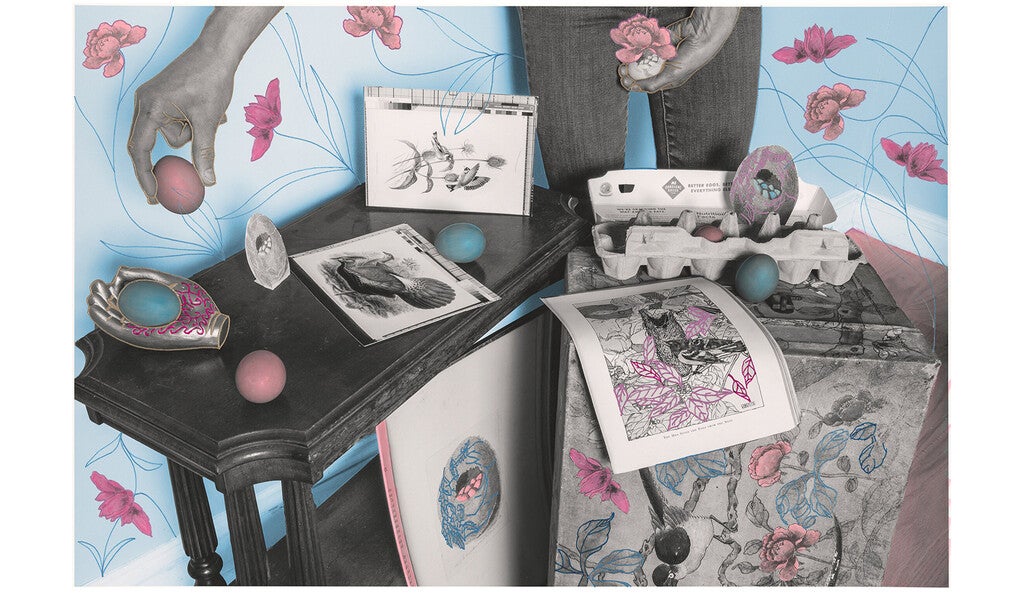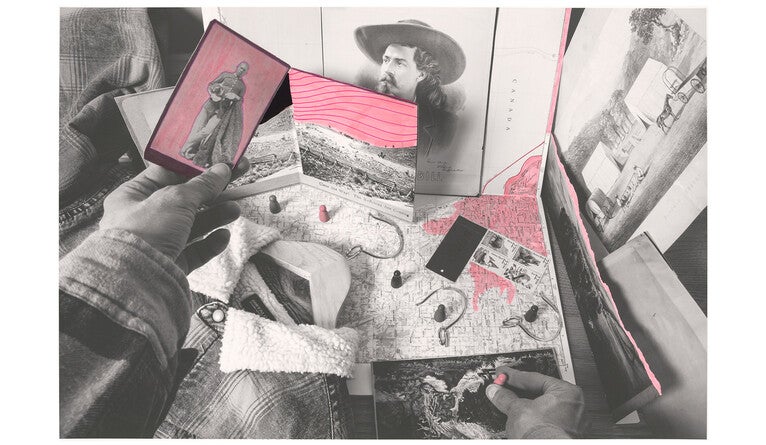Dreaming animals: Beinecke archives inspire campus artistic collaboration

“Bird in the Hand” (Photos by Meredith Miller)
Early in the pandemic, when much of Yale’s campus was shut down, Meredith Miller ’03 M.F.A. found inspiration in the Beinecke Rare Book and Manuscript Library’s digital collections.
Miller, a senior photographer at the Beinecke, turned to her artistic practice while the library’s facilities were closed. She began searching the digital collections for images of animals from manuscripts, books, and photographs, acquiring a virtual menagerie of exotic, threatened, or endangered species, including rhinos, elephants, and buffaloes.
Miller transformed this motley zoo into a series of playful still-life photographs, each featuring a different animal. Then she invited her Beinecke colleague MaryJane “MJ” Millington to compose poems to accompany the photographs. Millington’s verses and Miller’s images form “Dreaming Animals,” an exhibit on the Yale Health Center’s third floor that explores the complex relationship between humans and wildlife, probing the contradictions in how people claim to love and treasure animals while often treating them with indifference or cruelty.
“Working on this project made us reconsider humanity’s relationship with animals,” said Millington, a catalog assistant at the Beinecke. “We surround ourselves with animals and with images of animals. They are infused into our language, culture, and perceptions of ourselves. Yet, we often don’t do very much to protect them or their habitats, even when they’re endangered.”

The pair mounted the exhibit with the support of a Yale Environmental Humanities Grant, a program available to students, staff, and faculty that funds public humanities projects broadly related to the environment. The Beinecke Library matched the grant. (Because the exhibit is mounted in a health care facility, and given COVID-19 precautions, it is viewable only to those with business at the Health Center, not the general public.)
Miller began thinking about pursuing a personal project on animals the year before the pandemic while working in the library’s digital studio where she photographs collections materials for researchers. Many of the books and manuscripts she encounters contain depictions of animals, including images that stretch back centuries.
“When you photograph a woodcut print and turn the page, you can still see the outline of the animal through the page, which made me think of how animals are disappearing,” she said.
To create the still-life images, Miller printed out and manipulated the images she discovered in the Beinecke’s digital collections — enlarging or shrinking them, adding color here or removing it there, sometimes cutting out portions of a picture. Then she would find objects around her house that related to the featured animal in some way, such as a pencil with a giraffe carved on it or ceramic bowls overturned to represent a camel’s humps. She shot the photographs in her kitchen or a corner of her bedroom. For some, she added color in Photoshop, and handed-colored others, to create a visual map through the image. The titles reference children’s games themed on the animal depicted in each still life.
She decided to submit one of the pieces, a still life about birds, to a competition held by the Vermont Studio Center, a nonprofit organization that offers residency programs for artists and writers. Miller did a residency at the center in the summer of 2004, making her eligible for the contest. In preparing the submission, she realized that the contest rules required that text accompanied the photographs. So she contacted Millington, a published poet, to contribute a poem. Their work earned inclusion in a printed collection of the winning broadsides and in an exhibition at the center.
And a successful collaboration was born.
Millington wrote the poems based on her impressions of the images without discussing them with Miller. “They were all mysterious to me,” said Millington, who produces “Rime,” a podcast that shares tales from the history of poetry. “They’re dense and possess an esoteric quality. Meredith never pressured me to take a certain approach to an image. Instead, I tried to look into them and understand the direction she was going and what they made me think about.”
She wrote knowing that the idea of games and children’s associations with animals had partly inspired her collaborator. In some cases, she seized on wordplay and tropes and cliches about animals, such as the notion that elephants never forget. In other instances, historical research informed her work. For example, her poem “Zarafa, 1827” accompanying a giraffe-themed still life draws on the story of a female Nubian giraffe that was kept in the Jardin des Plantes botanical garden in Paris from 1827 until her death in 1845.

“Uh-Oh Elephant,” the still life Miller created featuring the trunk-wielding pachyderms is centered on a woodcut print of an elephant taken from “Cosmographie de Levant,” a 16th century travelogue by French explorer, geographer, and Franciscan priest Andre Thevet about his journey to Constantinople and holy sites.
Miller colored the elephant’s ear blue. She added blue in the space beneath its trunk and belly. The edges of the picture are torn. Miller’s fingers enter the scene from below the elephant. A plastic yellow elephant — a party favor from her 10th birthday — is clipped to her index finger, referencing the practice of tying a string around one’s finger to not forget something. The scene also includes jars of unsalted peanut butter Miller feeds to her dog that have an elephant on their labels. An IKEA tray with an elephant pattern provides a backdrop. An elephant-bedecked page from “Funny Leaves for the Younger Branches,” a 19th-century children’s book, completes the scene.
Millington’s poem, “Never Forget,” reads:
What is remembering made of?
Sun and pain,
water and dust;
an eye for an eye,
a tusk for a tusk.
In all, the exhibit features 17 poet-photographer collaborations, including reflections on birds, butterflies, buffaloes, giraffes, rhinos, whales, bees, and bears. All are playful yet plaintive, tinged with the lament over the people’s failure to fully respect and preserve the animal kingdom. And don’t miss the stylized artist photos of Miller and Millington, which share the same whimsical spirit as the poems and pictures.

The artists approached the Health Center about exhibiting the works as they had an existing relationship there. Miller founded The Arts at Yale Health, a program that brings beautiful and intellectually stimulating artworks to the building’s public spaces. Both Miller and Millington belong to the program’s organizational committee. “Dreaming Animals” is not part of the program, which has a formal selection process. It just happened that the Health Center had available wall space and an ongoing desire to provide its visitors and staff with lively and thought-provoking artwork to enjoy.
“‘Dreaming Animals’ is a very special addition to an already special arts program brought to us by Meredith,” said Peter Steere, chief operating office at the Yale Health Center. “When Meredith and MJ approached us with the idea for this exhibit, even when so many pieces were still in development, it was impossible to say no. That we have this beautiful work in its premier show — expecting it to travel to who knows where in the future — is another gift to our patients and staff members.”
The wall labels with Millington’s poems have QR codes that allow visitors to listen to the author recite the verses through their smartphones.
“Not only does that enhance accessibility, but sometimes poems feel more meaningful when you hear them as opposed to reading the text,” Millington said.
Recordings of the poems, paired with the still lifes, are available on SoundCloud. Miller and Millington are in discussions with the New Haven Public Library to mount the exhibit at the Mitchell Branch in the city’s Westville neighborhood in the fall. To learn more about the artists’ work, visit Miller’s website and Millington’s website.
Media Contact
Bess Connolly : elizabeth.connolly@yale.edu,